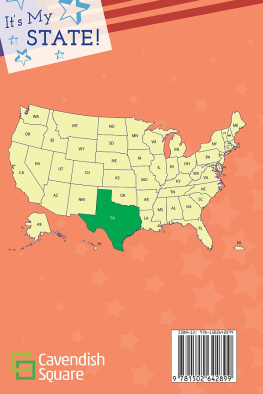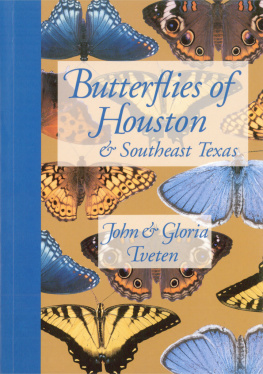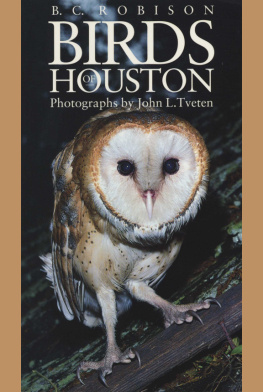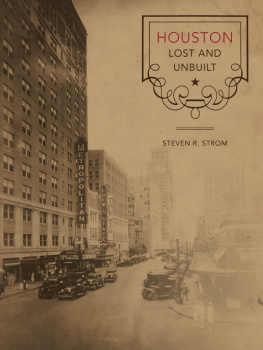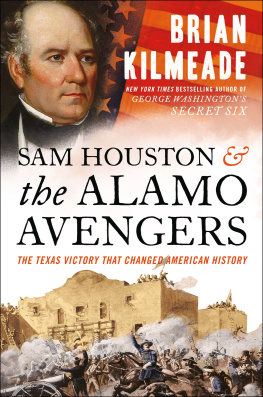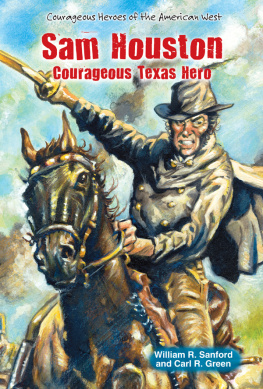ALL RIGHTS RESERVED. No part of this book may be reproduced in any form without written permission from the publisher, except for brief passages included in a review appearing in a newspaper or magazine.
| Copyright 2016 By Bill ONeal Published By Eakin Press An Imprint of Wild Horse Media Group P.O. Box 331779 Fort Worth, Texas 76163 1-817-344-7036 www.EakinPress.com ALL RIGHTS RESERVED 1 2 3 4 5 6 7 8 9 ebook 978-1-68179-191-3 Hardback ISBN 978-1-68179-192-0 Paperback ISBN-13: 978-1-68179-037-4 |
Cover Design by Flying Gorilla Studio
www.FlyingGorillaStudio.com
Dedicated to three history-minded individuals who have provided exceptional support during my tenure as Texas State Historian:
Mary Frances Payne Murphy, whose Texas roots trace back to the Lone Star Republic, and whose grandfather during boyhood occasionally shared his bed with a noted visitor from HuntsvilleSam Houston.
Foster Murphy, a World War II veteran and an accomplished businessman who, with his wifes approval, created the Murphy-Payne Foundation to establish a history lecture series at Panola College and to assist other history programs on campusincluding activities of the State Historian.
Dr. Gregory Powell, whose presidency at Panola College truly has been a study in leadershipgifted, resourceful, visionary leadership.
Contents
Acknowledgments
What Historians Said About Sam Houston
Military and Public Service of Sam Houston
ChapterOneThe Making of a Leader
ChapterTwoCombat Leader
ChapterThreeRise of a Political Leader
ChapterFourInfluence of Prominent Leaders on Sam Houston
ChapterFiveLeader in Disgrace
ChapterSixLeader Reborn
ChapterSevenGone to Texas
ChapterEightRevolution
ChapterNineLeading a Strategic Retreat
ChapterTenSan Jacinto
ChapterElevenPresident of Texas
ChapterTwelveLessons in Leadership for the Regulators and Moderators
ChapterThirteenSenator Houston
ChapterFourteenGovernor Houston
ChapterFifteenRemembering a Leader
Rest in Peace
Leadership Principles of Sam Houston
Endnotes
Bibliography
Index
Author Bio
Acknowledgments
Shortly after I was appointed State Historian of Texas in Austin in 2012, I was asked to deliver a lecture at the Bob Bullock Texas State Museum in Austin. My invitation came from museum director Joan Marshall, who requested that I provide a presentation on Leadership Qualities of Sam Houston. I taught Texas history at Panola College for more than three decades, and every year I became more aware of the varied and powerful leadership roles played by Houston. Focusing on Houston as a leader was a captivating assignment, and audience response at the Bob Bullock Museum was most gratifying. After I was asked to deliver the program to other groups, I began to see the possibilities of developing the subject into a book, and Ron Chrisman, Director of the University of North Texas Press, offered excellent advice regarding the direction of the manuscript.
The focus of this book is to trace Sam Houstons evolution as a leader and to emphasize his leadership skills and gifts. Standard biographical information is relied upon, although I believe I added new dimensions to Houstons performance during the Regulator-Moderator War, having written a book on that conflict (War in East Texas: Regulators vs. Moderators, 2006). Therefore, footnoting is largely utilized for quotes from Houston or his contemporaries, as well as from Houston biographers and historians.
I traveled to the sites of Houstons life, even though I had visited most of these placessome of them many timesin past years. Accompanied by my wife Karon, I drove to Virginia and the Sam Houston Wayside adjacent to his birthplace and boyhood home. In eastern Tennessee I photographed and hiked across the homestead where the family relocated in 1806. Nearby we saw the churchyard where Houstons mother is buried, several miles south of Maryville. A few miles on the other side of town is the Sam Houston Schoolhouse, a log structure where Houston taught as a young man. Nearby is a museum presided over by Bob and Mary Lynne Bell, who live on the grounds, and who were most helpful to us. At Lebanon, Tennessee, there is a replica structure which represents Sam Houstons first law office. Not far to the west is the Hermitage, Andrew Jacksons plantation home where Sam Houston was a frequent visitor. State museums in Nashville offer fine exhibits on Houston.
In Alabama we toured Horseshoe Bend National Battlefield Park. It was my first visit in nearly four decades, and there were many improvements. A couple of hours to the east is Marion, home town of Margaret Lea Houston. The director of the Chamber of Commerce, John L. Martin, guided us to the Lea home where Margaret wed Houston, to the college she attended, and to the boarding house he stayed in on trips to Marion. In Oklahoma we visited Fort Gibson and the grave of Tiana Rogers, along with Fort Towson, where Houston departed Indian Territory to cross the Red River into Texas.
In Texas, of course, there are a great many Houston sites. Among the most important are Nacogdoches and San Augustine, as well as the Halfway House Stagecoach Inn between them; Washington-on-the-Brazos, with its replica of Independence Hall, Anson Jones plantation complex, and the Star of Texas Museum; and of course the San Jacinto Battlefield and Monument. In Huntsville are Houstons favorite home, the house in which he died, his impressive gravesite, museums, and an enormous statue. Mac Woodward, director of Huntsvilles Sam Houston Memorial Museum, answered my questions with patient command of all Houstonian matters. He explained to me that the museum staff regularly meets to discuss various aspects of Houstons personality or achievements or problems. He pointed out to me that Houston knew and had contact with fourteen United States presidents. We speculated on how this exposure and interaction with leaders at the highest level influenced Houston, and I explored this topic in Chapter Four. Sam Houston Regional Library near Liberty is a repository for more Houston images than in any other institution.
At every step on the trail of Houston I was enlightened in ways large and small. From museum and park officials I received information and printed materials and directions, and I am indebted to everyone who aided a fellow Houston enthusiast. My wife and I shot hundreds of photographs along the way, and here and there I sensed a few ghosts from Houstons past.
My office as State Historian is located on the campus of Panola College in Carthage, where I taught history and where my wife is a member of the math faculty. Sherri Baker, research librarian at Panola, applied her formidable detective skills in locating obscure sources for me through interlibrary loan service. I engaged Jessica Liles, a Panola student who performs secretarial work for my wife, to convert a major portion of my pencil and pad manuscript to electronic form, and she was conscientious and efficient.


